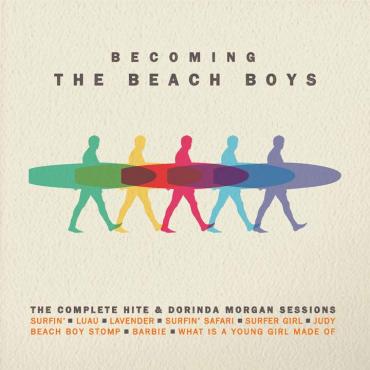The Complete Pre-Capitol Session Tapes

Before there was “The Beach Boys,” there was a garage band called the Pendletones, formed by three brothers, a cousin, a friend and a domineering father whose own show business dreams had never come to fruition. The harmony vocals of the 1950s and the surf sounds of the early ‘60s provided the ambitious Brian Wilson stepping stones to musical immortality, and these two discs of pre-Capitol sides paint the most complete picture yet of Wilson’s first steps towards the beach. From the Fall of 1961 until their signing to Capitol in the Spring of 1962, the Beach Boys recorded nine songs for Hite and Dorinda Morgan, with “Surfin’” b/w “Luau” released as a single on the Candix and X labels. The A-side charted at #75 nationally, but was a huge local hit on Los Angeles’ powerhouses KFWB and KRLA.
The group recorded additional material for the Morgans, including Beach Boys icons, “Surfin’ Safari” and “Surfer Girl,” but only one other single, “Barbie” b/w “What is a Young Girl Made Of” was released in the U.S., and then with Brian, Carl and Audree Wilson singing under the name Kenny and the Cadets to pre-produced backing tracks. The rest of the recordings were consigned to the vault, coming to light only after the group had established themselves on Capitol. Omnivore’s two-disc set gathers together the pre-Capitol master takes and all of the extant session material, including demos, rehearsals, studio chatter, false starts, overdubs and alternates. At sixty-two tracks covering only nine songs, this set isn’t for the casual listener, but for fans who have imbibed every detail of the masters, it’s a welcome peek into the group’s embryonic creative process.
Among the most surprising elements of this set is the fidelity of the tapes. It may not match what Brian himself achieved at Goldstar and elsewhere, but even the demos are clean and the studio productions are quite crisp. That said, take after take of the same song, often with only minute differences to break up the repetition, is both a revealing and an exhausting experience. The sessions document the arduous job of capturing a perfect live take from a nascent group with no studio experience, the group and their producer gaining confidence on each track as they try it again and again. Though there was limited overdubbing of guitar leads and lead vocals (and for “Surfin’ Safari,” a ragged stereo mix), the core of these takes are a quintet posed around microphones, hoping that no one screws up.
“Surfin’ Safari” and “Surfer Girl” were reborn at Capitol (the former with reworked lyrics, the latter shaking off the morose tone of this early version), but the rest of the material failed to make the jump. Dorinda Hite’s “Lavender” is sung in acapella harmony for the demos and augmented by bass and acoustic guitar on studio takes. Hite’s “Barbie” is a novelty tune redeemed largely by Brian’s tender lead vocal and the production’s stereo mix; its flip “What is a Young Girl Made Of” is a frantic 50s-styled R&B song that even Brian’s lead vocal can’t redeem. Brian Wilson’s “Judy” is a bouncy pop tune written for his then-girlfriend Judy Bowles; the master take shows how the group filled out bare demos with Carl’s guitar and Brian’s sincere, enthusiastic lead vocal. Carl’s “Beach Boy Stomp” is a basic instrumental that picks up steam as the group plays it a few times, paving the way to “Stoked,” “Surf Jam” and “Shut Down, Part II.”
The set’s most revealing moment occurs at the end of six takes of “Surfer Girl.” Unable to play bass and nail down his vocal, Brian Wilson realizes that overdubbing would allow him to focus on singing. His request is curtly shut down by Hite Williams, who either didn’t understand its value, or didn’t want to pay for extra studio time. To add insult to injury, there’s an extra overdub with an unknown and uncompelling lead vocalist. No doubt this helped plant the seeds of self-production in Wilson’s head. Moments like this are a music archaeologist’s dream, and in a sense this entire set is like a dig through a museum’s archive. This isn’t something you’ll track through on a regular basis, but there are subtle, important discoveries to be made here, and you’ll enjoy having them pop up on shuffle. Some of this material was released on 1991’s Lost & Found, but this full rendering, packaged in a tri-fold digipak with a 20-page booklet and liner notes from James Murphy, is the one to get. [©2016 Hyperbolium]




